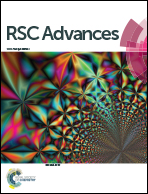Manipulating multi-system of NADPH regulation in Escherichia coli for enhanced S-adenosylmethionine production†
Abstract
S-adenosylmethionine (SAM) is an essential regulatory compound in many biological reactions and an active small molecule of high biomedical value. Cofactor engineering as an advantageous and emerging strategy was introduced to improve the SAM production. In this work, we constructed two kinds of NADPH regenerators of heterologous NADH kinase (Pos5p) and NADH kinase-like enzymes (combination of transhydrogenase PntAB and NAD kinase YfjB) to increase the availability of NADPH in SAM biosynthesis. Modulating of Pos5p resulted in a superior SAM production and led to approximately 5.30 mg L−1 of SAM in Escherichia coli without L-methionine addition. In addition, the synthetic sRNA-based NADPH regulation strategy was also implemented for enhancing the NADPH supply coupled with decreasing the by-products in the SAM synthesis pathway. The SAM titer of the recombinant strains harboring synthetic sRNA could exceed 1 mg L−1, which increased approximately 70% than that of the control. It was also proposed that the production of SAM is not only dependent on the absolute value of NADPH but also dependent on the NADPH/NADP+ ratio. These NADPH regulation strategies are potentially applicable to various processes for enhancing of NADPH-dependent products.


 Please wait while we load your content...
Please wait while we load your content...